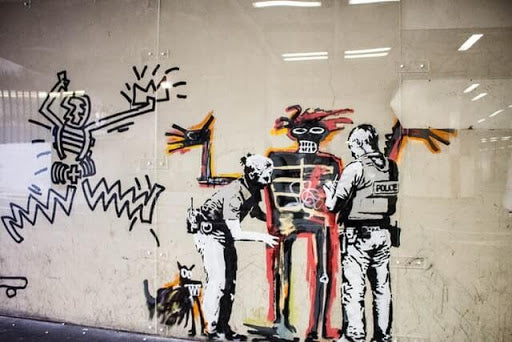Graffiti art is a form of street art that involves creating images, messages, or designs on various surfaces, typically without the permission of the property owner. It has its roots in ancient civilizations, such as the Greeks and the Romans, who used graffiti as a way to communicate their thoughts, ideas, and feelings.
In modern times, graffiti has evolved into a vibrant and creative art form that is enjoyed by millions of people around the world.
The purpose of this article is to provide a comprehensive guide to understanding and practicing graffiti art. It will cover the basics of graffiti art, including the materials needed, different styles, and how to find a suitable practice space.
The article will also provide tips and advice on how to develop your skills as a graffiti artist, improve your artwork, and get involved in the graffiti art community.

Understanding The Basics Of How To Practice Graffiti Art?
Graffiti art requires a few basic materials, including spray cans, markers, stencils, and paintbrushes. It is important to learn the graffiti alphabet, which is a series of letters and symbols that are commonly used in graffiti.
There are many different styles of graffiti art, ranging from traditional styles like block lettering and wildstyle to more contemporary styles like abstract and photo-realistic.
Finding a Suitable Practice Space
Graffiti art can be either legal or illegal, depending on whether the artist has the permission of the property owner. It is important to choose an appropriate surface to practice on, such as walls, canvases, or paper. Safety precautions should also be taken, such as wearing protective gear and taking measures to prevent inhalation of spray paint fumes.
Developing Your Skills
Practicing with different tools and experimenting with different styles is crucial to developing your skills as a graffiti artist. Finding inspiration from other artists and creating your own unique style is also important.
10-step-by-step process with some tips for the topic How to practice graffiti art?
- Learn the basics of graffiti art: Study the graffiti alphabet, different styles of graffiti art, and the materials needed for the art form.
- Gather your materials: You will need spray cans, markers, stencils, and paint brushes to practice graffiti art. Make sure to choose high-quality materials that are suitable for your specific needs.
- Choose a suitable practice space: Look for legal graffiti spaces, such as graffiti parks or community walls, or practice on canvases or paper indoors.
- Wear protective gear: To keep yourself safe while practicing graffiti art, make sure to wear protective gear, such as gloves and a mask, and take measures to prevent inhalation of spray paint fumes.
- Start practicing: Experiment with different tools and styles, and try to create your own unique style.
- Study the work of other graffiti artists: Find inspiration from other artists, and study their work to learn new techniques and ideas.
- Take breaks: Graffiti art can be physically and mentally demanding, so make sure to take breaks and give yourself time to rest and recharge.
- Critique your own work: Take the time to critique your own work and identify areas for improvement.
- Seek feedback from other artists: Join graffiti art communities and seek feedback from other artists to help improve your skills.
- Keep learning and evolving: Graffiti art is an evolving art form, so make sure to continuously learn and evolve your skills and style.
Tips:
- Don’t be afraid to make mistakes. Mistakes are a natural part of the learning process, and they can help you to grow as an artist.
- Keep a sketchbook to practice your lettering and sketch out ideas.
- Join a graffiti art community to connect with other artists, learn from them, and get feedback on your work.
- Take the time to practice regularly, even if it’s just for a few minutes a day. Consistent practice will help you to develop your skills and improve your work.
Improving Your Graffiti Art
Continuously critiquing your own work and seeking feedback from other artists is essential for improving your graffiti art. Participating in graffiti art communities and continuing to learn and evolve will also help you to grow as an artist.
Some Querries People Looking For In Forum Reddit & Quora!
- Q: What are the essential materials needed to start practicing graffiti art?
A: Essential materials for practicing graffiti art include spray cans, markers, stencils, and paint brushes.
- Q: How can I learn the graffiti alphabet and improve my lettering skills?
A: Practicing lettering and studying the work of other graffiti artists can help you improve your lettering skills and learn the graffiti alphabet.
- Q: Is it possible to practice graffiti art legally, and if so, where can I find suitable spaces to practice?
A: There are legal graffiti spaces, such as graffiti parks and community walls, where you can practice your art. You can also use canvases or paper to practice indoors.
- Q: What are some tips for developing my skills as a graffiti artist?
A: To develop your skills as a graffiti artist, it’s important to experiment with different tools and styles, find inspiration from other artists, and create your own unique style.
- Q: How can I improve my graffiti art and get feedback from other artists?
A: To improve your graffiti art, you can critique your own work, seek feedback from other artists, participate in graffiti art communities, and continuously learn and evolve.
how to be a good graffiti artist?

Becoming a good graffiti artist requires dedication, hard work, and a willingness to continuously learn and evolve. Here are some steps you can take to help you become a good graffiti artist:
- Study the basics: Learn the graffiti alphabet, different styles of graffiti art, and the materials needed for the art form.
- Gather high-quality materials: Make sure you have the right tools, such as spray cans, markers, stencils, and paint brushes, to create high-quality graffiti art.
- Choose a suitable practice space: Look for legal graffiti spaces, such as graffiti parks or community walls, or practice on canvases or paper indoors.
- Wear protective gear: To keep yourself safe while practicing graffiti art, make sure to wear protective gear, such as gloves and a mask, and take measures to prevent inhalation of spray paint fumes.
- Practice regularly: Dedicate time to practice graffiti art on a regular basis. Experiment with different tools and styles, and try to create your own unique style.
- Study the work of other graffiti artists: Find inspiration from other artists, and study their work to learn new techniques and ideas.
- Critique your own work: Take the time to critique your own work and identify areas for improvement.
- Seek feedback from other artists: Join graffiti art communities and seek feedback from other artists to help improve your skills.
- Keep learning and evolving: Graffiti art is an evolving art form, so make sure to continuously learn and evolve your skills and style.
- Be patient and persistent: Becoming a good graffiti artist takes time and patience. Don’t get discouraged by setbacks, and keep working towards your goal.
Conclusion
In conclusion, graffiti art is a vibrant and creative form of that has a rich history and a dedicated following. By understanding the basics, finding a suitable practice space, developing your skills, and continuously improving your work, you can become a skilled and successful graffiti artist.
With its unique style, graffiti art is an important and valuable form of artistic expression that should be celebrated and encouraged.
Ruth Aquilani is a renowned graffiti artist known for her bold, colorful, and expressive style. She began her career as a street artist in the early 2000s, quickly making a name for herself in the graffiti community with her unique and striking works of art.

[…] it encompasses a diverse range of styles, including tags, throw-ups, stencils, murals, and more. Graffiti art serves as a powerful means of communication, reflecting social issues, political statements, and […]
[…] classical paintings, Renaissance masterpieces, and popular culture. He was also influenced by the graffiti art that started appearing on the walls of Paris in the late […]
[…] this list is focused on contemporary artists. The list is based on the artist’s impact on the graffiti art movement, their style and technique, and their influence on other graffiti […]